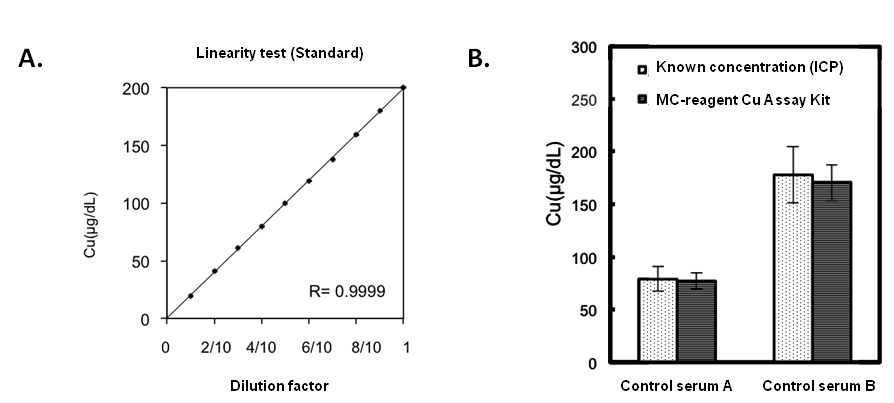Copper Colorimetric Assay Kit
Product Code:
JAI-CCU-400
JAI-CCU-400
Regulatory Status:
RUO
RUO
Shipping:
BLUE ICE
BLUE ICE
Storage:
+4°C
+4°C
No additional charges, what you see is what you pay! *
| Code | Size | Price |
|---|
| JAI-CCU-400-100tests | 100 tests | £586.00 |
Quantity:
Prices exclude any Taxes / VAT
Stay in control of your spending. These prices have no additional charges, not even shipping!
* Rare exceptions are clearly labelled (only 0.14% of items!).
* Rare exceptions are clearly labelled (only 0.14% of items!).
Multibuy discounts available! Contact us to find what you can save.
This product comes from: Switzerland.
Typical lead time: 10-14 working days.
Contact us for more accurate information.
Typical lead time: 10-14 working days.
Contact us for more accurate information.
- Further Information
- Documents
- References
- Related Products
- Show All
Further Information
Detection Type:
Colorimetric
EClass:
32160000
Form (Short):
liquid
Handling Advice:
Do not freeze.
Kit Contains:
1 x 24 ml R-1 Buffer (with reductant) (ready to use) | 1 x 0.5 ml R-2 Chelate color (ready to use) | 1 x 1.2 ml STD Copper (Cu) standard 200 µg/dL (ready to use)
Long Description:
This MC-Reagent Copper Assay Kit is a direct colorimetric assay based on the 3,5-DiBr-PAESA method without deproteinization of the sample. A week acid buffer dissociates copper from the ceruloplasmin-copper complex and is reduced by ascorbic acid (Cu2+ >> Cu+). Cu+ ions form a blue colored complex with the chromogen 3,5-DiBr-PAESA. The color intensity is proportional to the copper concentration in the sample. Absorbance of the Cu+-complex is measured at 580nm. Wavelength range of sensitivity: 570 ~ 590nm. Features of this Assay: Quick & Easy to use • Species independent • Highly sensitive, stable and suitable for high-throughput testing • No toxic substances • For cell lysates, serum, plasma and wide variety of biological samples
Other data:
This MC-Reagent Copper Assay Kit is a direct colorimetric assay based on the 3,5-DiBr-PAESA method without deproteinization of the sample. A week acid buffer dissociates copper from the ceruloplasmin-copper complex and is reduced by ascorbic acid (Cu2+ >> Cu+). Cu+ ions form a blue colored complex with the chromogen 3,5-DiBr-PAESA. The color intensity is proportional to the copper concentration in the sample. Absorbance of the Cu+-complex is measured at 580nm. Wavelength range of sensitivity: 570 ~ 590nm. Features of this Assay: Quick & Easy to use • Species independent • Highly sensitive, stable and suitable for high-throughput testing • No toxic substances • For cell lysates, serum, plasma and wide variety of biological samples
Package Type:
Box
Product Description:
Copper (Cu+) is an essential trace element (i.e. micronutrient) and cofactor. 95% of copper in plasma is in complex with enzymes, mostly with ceruloplasmin, several oxidases and dismutases, which play important roles in iron and catecholamine metabolism, free radical scavenging, and in the synthesis of haemoglobin and elastin. The micronutrient is necessary for the proper growth, development, and maintenance of bone, connective tissue, brain, heart, and many other body organs. Copper is involved in the formation of red blood cells, the absorption and utilization of iron, the metabolism of cholesterol and glucose, and the synthesis and release of life-sustaining proteins and enzymes. These enzymes in turn produce cellular energy and regulate nerve transmission, blood clotting, and oxygen transport. Copper stimulates the immune system to fight infections, to repair injured tissues, and to promote healing. Copper also helps to neutralize "free-radicals", which can cause severe damage to cells. Copper deficiency lowers the anti-oxidant function in vivo and has been associated with mental retardation, depigmentation, anemia, hypotonia and scorbutic changes in bone. Levels of copper are key diagnostic indicator of diseases such as cardiopathy, osteoporosis, osteoarthritis, Menkes syndrome and Wilson's disease. Acute copper toxicity can cause gastroenteritis and acute renal failure.
Range:
3 - 400µg/dL
Sample Type:
Cell Lysate, Plasma, Saliva, Serum, Tissue Supernatant, Urine
Specificity:
Specific to Cu2+ and Cu+.
Transportation:
Non-hazardous
UNSPSC Category:
Chemical Reagent Kits
UNSPSC Number:
41116104
Use & Stability:
12 months after the day of manufacturing. See expiry date on ELISA Kit box.
Documents
References
Enhanced biofilm formation and/or cell viability by polyamines through stimulation of response regulators UvrY and CpxR in the two-component signal transducing systems, and ribosome recycling factor: A. Sakamoto, et al.; Int. J. Biochem. Cell Biol. 44, 1877 (2012) | A Primary Role for Disulfide Formation in the Productive Folding of Prokaryotic Cu,Zn-superoxide dismutase: Y. Sakurai, et al.; J. Biol. Chem. 289, 20139 (2014)
Related Products
| Product Name | Product Code | Supplier | Calcium Colorimetric Assay Kit (Chlorophosphonazo III Method)) | JAI-CCA-020 | JaICA | Summary Details | |||||||||||||||||||||||||||||||||||||||||||||||||||||||||||||||||||||||||||||||||||||||||||||
|---|---|---|---|---|---|---|---|---|---|---|---|---|---|---|---|---|---|---|---|---|---|---|---|---|---|---|---|---|---|---|---|---|---|---|---|---|---|---|---|---|---|---|---|---|---|---|---|---|---|---|---|---|---|---|---|---|---|---|---|---|---|---|---|---|---|---|---|---|---|---|---|---|---|---|---|---|---|---|---|---|---|---|---|---|---|---|---|---|---|---|---|---|---|---|---|---|---|---|---|
| Calcium Colorimetric Assay Kit (o-Cresolphthalein-Complexone Method) | JAI-CCA-030 | JaICA | Summary Details | ||||||||||||||||||||||||||||||||||||||||||||||||||||||||||||||||||||||||||||||||||||||||||||||||
| Iron Colorimetric Assay Kit (Ferrozine Method) | JAI-CFE-005 | JaICA | Summary Details | ||||||||||||||||||||||||||||||||||||||||||||||||||||||||||||||||||||||||||||||||||||||||||||||||
| Iron Colorimetric Assay Kit (Nitroso-PSAP Method) | JAI-CFE-010 | JaICA | Summary Details | ||||||||||||||||||||||||||||||||||||||||||||||||||||||||||||||||||||||||||||||||||||||||||||||||
| Magnesium Colorimetric Assay Kit (Yyridil Blue-I Method) | JAI-CMG-035 | JaICA | Summary Details | ||||||||||||||||||||||||||||||||||||||||||||||||||||||||||||||||||||||||||||||||||||||||||||||||
| Zinc Colorimetric Assay Kit | JAI-CZN-001 | JaICA | Summary Details | ||||||||||||||||||||||||||||||||||||||||||||||||||||||||||||||||||||||||||||||||||||||||||||||||
| Total Antioxidant Capacity (PAO) Test Kit | JAI-KPA-050 | JaICA | Summary Details | ||||||||||||||||||||||||||||||||||||||||||||||||||||||||||||||||||||||||||||||||||||||||||||||||



